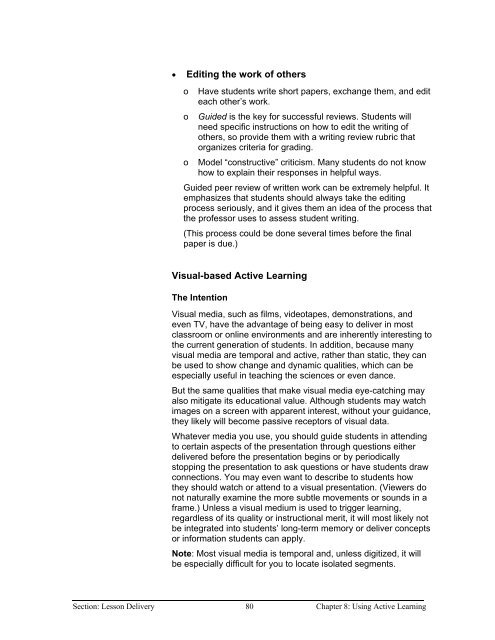Chapter 9 - Instructional Media: Chalkboards to Video - CGISS
Chapter 9 - Instructional Media: Chalkboards to Video - CGISS
Chapter 9 - Instructional Media: Chalkboards to Video - CGISS
You also want an ePaper? Increase the reach of your titles
YUMPU automatically turns print PDFs into web optimized ePapers that Google loves.
• Editing the work of others<br />
o<br />
o<br />
o<br />
Have students write short papers, exchange them, and edit<br />
each other’s work.<br />
Guided is the key for successful reviews. Students will<br />
need specific instructions on how <strong>to</strong> edit the writing of<br />
others, so provide them with a writing review rubric that<br />
organizes criteria for grading.<br />
Model “constructive” criticism. Many students do not know<br />
how <strong>to</strong> explain their responses in helpful ways.<br />
Guided peer review of written work can be extremely helpful. It<br />
emphasizes that students should always take the editing<br />
process seriously, and it gives them an idea of the process that<br />
the professor uses <strong>to</strong> assess student writing.<br />
(This process could be done several times before the final<br />
paper is due.)<br />
Visual-based Active Learning<br />
The Intention<br />
Visual media, such as films, videotapes, demonstrations, and<br />
even TV, have the advantage of being easy <strong>to</strong> deliver in most<br />
classroom or online environments and are inherently interesting <strong>to</strong><br />
the current generation of students. In addition, because many<br />
visual media are temporal and active, rather than static, they can<br />
be used <strong>to</strong> show change and dynamic qualities, which can be<br />
especially useful in teaching the sciences or even dance.<br />
But the same qualities that make visual media eye-catching may<br />
also mitigate its educational value. Although students may watch<br />
images on a screen with apparent interest, without your guidance,<br />
they likely will become passive recep<strong>to</strong>rs of visual data.<br />
Whatever media you use, you should guide students in attending<br />
<strong>to</strong> certain aspects of the presentation through questions either<br />
delivered before the presentation begins or by periodically<br />
s<strong>to</strong>pping the presentation <strong>to</strong> ask questions or have students draw<br />
connections. You may even want <strong>to</strong> describe <strong>to</strong> students how<br />
they should watch or attend <strong>to</strong> a visual presentation. (Viewers do<br />
not naturally examine the more subtle movements or sounds in a<br />
frame.) Unless a visual medium is used <strong>to</strong> trigger learning,<br />
regardless of its quality or instructional merit, it will most likely not<br />
be integrated in<strong>to</strong> students’ long-term memory or deliver concepts<br />
or information students can apply.<br />
Note: Most visual media is temporal and, unless digitized, it will<br />
be especially difficult for you <strong>to</strong> locate isolated segments.<br />
Section: Lesson Delivery 80 <strong>Chapter</strong> 8: Using Active Learning
















